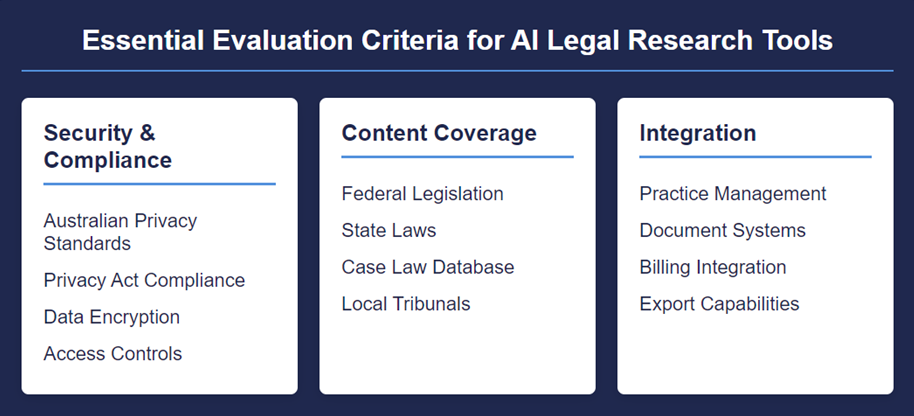As a lawyer having spent many years working in small to medium-sized law firms, I have first hand experience knowing how crucial it is to have the right tools in place to streamline our processes and provide the best service to clients.
Choosing an AI legal research tool isn’t just about getting access to case law—it’s about finding a solution that truly fits the unique needs of our practice.
I’ve put together this Checklist as how I would approach selecting the right tool, focusing on the common pain points we face in our industry.
- Essential Evaluation Criteria for AI Legal Research Tools
- 1. AI Legal Research Tools: Australian Legal Content Coverage
- 2. AI Legal Research Tools: Security and Compliance
- 3. AI Legal Research Tools: Cost Structure Analysis
- 4. AI Legal Research Tools: Technical Requirements
- AI Legal Research Tool Evaluation Checklist

Essential Evaluation Criteria for AI Legal Research Tools
1. AI Legal Research Tools: Australian Legal Content Coverage
The foundation of any AI legal research tool is its content coverage. When I’m evaluating a tool, I make sure it provides comprehensive access to all layers of our legal system.
- Federal and State Legislation: I check for instant access to Commonwealth legislation, Federal Court decisions, and High Court rulings. The tool must automatically update, cross-reference, and flag pending legislation.
- State-Specific Resources: Since many of us practice across jurisdictions, I ensure the tool covers all the states we work in. That includes:
- State legislation with point-in-time access
- Supreme Court decisions with proper citator tools
- Local tribunal decisions with effective search capabilities
- Cross-jurisdictional analysis features
2. AI Legal Research Tools: Security and Compliance
Given the sensitivity of client data, security is non-negotiable. When I evaluate AI tools, I ensure they comply with all Australian privacy and data protection laws.
- Data Storage: I look for tools that use Australian-based data centers and adhere to Australian Privacy Principles.
- Encryption: The tool must use industry-standard encryption, like 256-bit AES, and have clear data handling policies.
- Compliance: Regular security audits and clear breach notification protocols are must-haves for me.
3. AI Legal Research Tools: Cost Structure Analysis
We can’t afford to overlook the full cost of a tool, so I break it down beyond just the subscription fee.
- Initial Investment: Setup fees, data migration, integration, and training can add up quickly. I consider these carefully.
- Ongoing Costs: I check for monthly or annual subscriptions, per-user licensing fees, and additional costs like API usage or storage beyond limits.
- Hidden Costs: Unexpected expenses, like training refreshers, system upgrades, or custom integrations, can sneak up on us, so I factor them in when evaluating ROI.

Total Cost of Ownership Calculator
Calculate your ROI using this formula:
Monthly ROI = [(Hours saved × Billable rate) – (Monthly subscription + Training time cost)] / Initial investment
Related:
4. AI Legal Research Tools: Technical Requirements
The AI tool needs to work seamlessly with the systems we already use. I ensure it’s compatible with our practice management software and other tools we rely on daily.
- Software Compatibility: I make sure it integrates with practice management systems like LEAP or Actionstep.
- Mobile Access: The ability to access the tool from anywhere is crucial for today’s fast-paced legal world. I also check for offline functionality and export options.
- API Access: I need to know that the tool allows for custom integrations and batch processing, which can significantly improve our workflows.
5. Support and Training
Even the best tools are only effective if we know how to use them. I make sure the tool comes with robust support and training.
- Support Services: I look for providers who offer support during Australian business hours, with multiple contact options like phone, email, and chat. Response time guarantees are important to ensure help is available when we need it.
- Training Programs: I evaluate the quality of the onboarding process, ongoing training, and advanced feature tutorials. Custom workflow guidance is a bonus, as it can help tailor the tool to our practice’s specific needs.
By keeping these key factors in mind, I ensure that the AI legal research tool I choose is not only comprehensive and secure but also a good fit for the operational challenges we face in small to medium-sized law firms.
AI Legal Research Tool Evaluation Checklist









